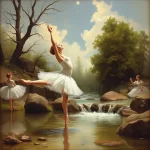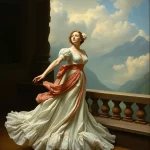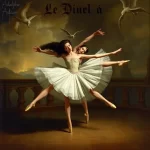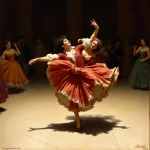Ballet: La Source (Léo Delibes and Ludwig Minkus, 1866)

Introduction
Ballet, an art form that combines music, dance, and storytelling, has produced numerous masterpieces over the centuries. One such gem is “La Source,” a ballet created in 1866 by the collaborative efforts of choreographer Arthur Saint-Léon and composers Léo Delibes and Ludwig Minkus. Premiered at the Paris Opera, “La Source” is a captivating tale that intertwines themes of love, magic, and nature. This article delves into the rich history, musical composition, choreography, and cultural impact of this enchanting ballet.
Historical Background
Creation and Development
“La Source” was conceived during a period of significant artistic and social change in Europe. The mid-19th century was marked by a fascination with exoticism and romanticism, which heavily influenced the arts. The ballet drew inspiration from Persian folklore and literature, reflecting the era’s interest in the mystical and the otherworldly.
The collaboration between Arthur Saint-Léon, Léo Delibes, and Ludwig Minkus was pivotal in bringing “La Source” to life. Saint-Léon, a renowned choreographer, was known for his innovative techniques and narrative-driven ballets. Delibes and Minkus, both accomplished composers, contributed their unique musical styles to create a rich and varied score that enhanced the ballet’s narrative and emotional depth.
Premiere and Reception
“La Source” premiered on November 12, 1866, at the Paris Opera. The initial reception was mixed, with some critics praising the ballet’s innovative choreography and enchanting music, while others found the plot convoluted. Despite the mixed reviews, the ballet gained popularity over time, leading to several notable early performances and revivals.
Synopsis of the Ballet
Act I Summary
The ballet opens in a picturesque valley where the nymph Naïla resides. Naïla is the guardian of a magical spring that grants eternal youth and beauty. The valley is visited by a group of travelers, including the noble hunter Djemil and his beloved Nouredda. Djemil becomes enchanted by Naïla’s beauty and the magical spring, leading to a series of misunderstandings and conflicts.
Act II Summary
In the second act, Djemil’s fascination with Naïla causes tension between him and Nouredda. Naïla, who has fallen in love with Djemil, uses her magical powers to create illusions and obstacles to keep him in the valley. However, Djemil’s love for Nouredda ultimately prevails, and he resists Naïla’s enchantments.
Finale
The ballet concludes with a dramatic resolution. Naïla, heartbroken by Djemil’s rejection, sacrifices herself to restore the magical spring. Her selfless act brings peace to the valley and reunites Djemil and Nouredda. The ballet ends with a celebration of love and harmony, underscored by the enchanting music of Delibes and Minkus.
Musical Composition
Composer’s Role
Léo Delibes and Ludwig Minkus played crucial roles in shaping the musical landscape of “La Source.” Delibes, known for his melodic inventiveness, composed the majority of the ballet’s score, while Minkus contributed several key pieces. Their collaboration resulted in a rich and varied musical tapestry that perfectly complemented Saint-Léon’s choreography.
Musical Themes and Motifs
The score of “La Source” is characterized by its recurring musical themes and leitmotifs. Delibes and Minkus used these motifs to represent different characters and emotions, enhancing the narrative and emotional depth of the ballet. For example, Naïla’s theme is ethereal and enchanting, reflecting her mystical nature, while Djemil’s theme is bold and heroic, underscoring his noble character.
Famous Recordings and Performances
Over the years, “La Source” has been performed by numerous prestigious ballet companies, and several recordings of its music have been made. Notable performances include those by the Paris Opera Ballet and the Bolshoi Ballet, both of which have brought their unique interpretations to the ballet’s music and choreography.
Choreography and Dance
Choreographer’s Vision
Arthur Saint-Léon’s vision for “La Source” was to create a ballet that combined technical brilliance with emotional storytelling. He introduced several innovative techniques, such as the use of mime to convey complex emotions and the integration of folk dance elements to enhance the ballet’s exotic atmosphere.
Signature Dance Numbers
“La Source” features several signature dance numbers that have become iconic in the world of ballet. The Pas de Deux between Naïla and Djemil is a highlight, showcasing the technical prowess and emotional depth of the dancers. Other notable scenes include Naïla’s solo performances, which are characterized by their ethereal beauty and intricate choreography.
Notable Interpretations
Over the years, different productions of “La Source” have brought their unique interpretations to the ballet’s choreography. Some have emphasized the romantic and mystical elements, while others have focused on the technical brilliance of the dance numbers. These varied interpretations have kept the ballet fresh and relevant for contemporary audiences.
Characters and Roles
Main Characters
- Naïla: The guardian of the magical spring, Naïla is a mystical nymph who falls in love with Djemil.
- Djemil: A noble hunter who becomes enchanted by Naïla and the magical spring.
- Nouredda: Djemil’s beloved, who becomes jealous of Naïla’s influence over him.
Supporting Characters
- Travelers: A group of characters who accompany Djemil and Nouredda to the valley.
- Villagers: Inhabitants of the valley who interact with the main characters.
Famous Dancers
Several renowned dancers have portrayed the lead roles in “La Source” over the years. Notable performers include ballerinas such as Sylvie Guillem and Svetlana Zakharova, who have brought their unique interpretations to the role of Naïla, and dancers like Rudolf Nureyev and Mikhail Baryshnikov, who have excelled in the role of Djemil.
Cultural and Artistic Impact
Influence on Ballet and Dance
“La Source” has had a significant influence on the world of ballet and dance. Its innovative choreography and enchanting music have inspired numerous choreographers and composers. The ballet’s integration of folk dance elements and its use of mime to convey complex emotions have become standard techniques in the ballet repertoire.
Cultural Significance
The ballet’s themes of love, magic, and nature have resonated with audiences for over a century. “La Source” has been referenced in literature, film, and other art forms, reflecting its enduring cultural significance. Its enchanting story and beautiful music continue to captivate audiences around the world.
Legacy and Revivals
“La Source” has seen numerous revivals and reinterpretations over the years. Major ballet companies such as the Paris Opera Ballet and the Bolshoi Ballet have staged productions of the ballet, bringing their unique interpretations to the choreography and music. These revivals have ensured that “La Source” remains a beloved and celebrated work in the world of ballet.
Iconic Productions
Historic Productions
One of the most famous historical productions of “La Source” was staged by the Paris Opera Ballet in the late 19th century. This production featured renowned dancers such as Carlotta Brianza and Pavel Gerdt, who brought their exceptional talent to the roles of Naïla and Djemil. The production was praised for its innovative choreography and enchanting music.
Contemporary Productions
Recent productions of “La Source” have brought new interpretations to the ballet’s choreography and music. Companies such as the Bolshoi Ballet and the Royal Ballet have staged contemporary productions that emphasize the ballet’s romantic and mystical elements. These productions have been praised for their technical brilliance and emotional depth.
Production Design
The production design of “La Source” has evolved over the years, with different productions bringing their unique interpretations to the set, costume, and lighting design. Historic productions often featured elaborate sets and costumes that reflected the exotic and mystical themes of the ballet. Contemporary productions have experimented with minimalist designs and modern lighting techniques to create a more abstract and ethereal atmosphere.
Critical Reception and Reviews
Initial Critical Response
At the time of its premiere, “La Source” received mixed reviews from critics. Some praised the ballet’s innovative choreography and enchanting music, while others found the plot convoluted and difficult to follow. Despite the mixed reviews, the ballet gained popularity over time and became a beloved work in the ballet repertoire.
Modern Reviews
Contemporary critics and audiences have generally been more favorable in their reviews of “La Source.” The ballet is praised for its technical brilliance, emotional depth, and enchanting music. Modern productions have been lauded for their innovative interpretations and their ability to bring new life to this classic work.
Fun Facts and Trivia
Behind-the-Scenes Stories
One interesting anecdote from the production of “La Source” involves the collaboration between Delibes and Minkus. Despite their different musical styles, the two composers worked harmoniously to create a cohesive and enchanting score. Their collaboration is often cited as a testament to the power of artistic collaboration.
Notable Performers
Several famous dancers have been associated with “La Source” over the years. Notable performers include ballerinas such as Sylvie Guillem and Svetlana Zakharova, who have brought their unique interpretations to the role of Naïla, and dancers like Rudolf Nureyev and Mikhail Baryshnikov, who have excelled in the role of Djemil.
Trivia
- “La Source” was one of the first ballets to integrate folk dance elements into its choreography.
- The ballet’s score features a unique combination of Delibes’ melodic inventiveness and Minkus’ rhythmic vitality.
- “La Source” has been referenced in various works of literature, film, and other art forms, reflecting its enduring cultural significance.
Conclusion
Summary of the Ballet’s Importance
“La Source” is a significant work in the world of ballet, known for its innovative choreography, enchanting music, and captivating story. The collaboration between Arthur Saint-Léon, Léo Delibes, and Ludwig Minkus resulted in a ballet that has inspired generations of dancers, choreographers, and composers.
Final Thoughts
“La Source” continues to captivate audiences with its timeless themes of love, magic, and nature. Its rich history, beautiful music, and innovative choreography make it a beloved work in the ballet repertoire. Whether you are a seasoned ballet enthusiast or a newcomer to the art form, “La Source” is a ballet that is sure to enchant and inspire.
FAQ
What is the central theme of this ballet?
The central theme of “La Source” is the interplay between love, magic, and nature, as well as the conflicts and resolutions that arise from these elements.
Who are the main characters in this ballet?
The main characters in “La Source” are Naïla, the guardian of the magical spring; Djemil, a noble hunter; and Nouredda, Djemil’s beloved.
What is the most famous dance number in this ballet?
The Pas de Deux between Naïla and Djemil is one of the most famous dance numbers in “La Source,” showcasing the technical prowess and emotional depth of the dancers.
How long does a typical performance of this ballet last?
A typical performance of “La Source” lasts approximately two hours, including intermissions.
Are there any modern adaptations of this ballet?
Yes, several modern adaptations of “La Source” have been staged by prestigious ballet companies such as the Bolshoi Ballet and the Royal Ballet, bringing new interpretations to the choreography and music.
Why is this ballet considered important in the history of dance?
“La Source” is considered important in the history of dance due to its innovative choreography, enchanting music, and its influence on subsequent works in the ballet repertoire. The collaboration between Saint-Léon, Delibes, and Minkus set a high standard for artistic collaboration in ballet.





